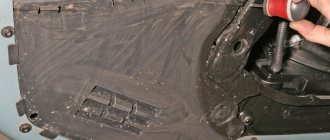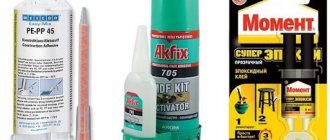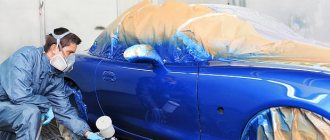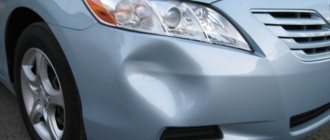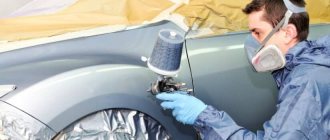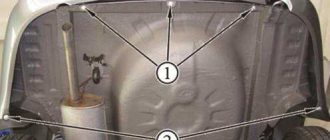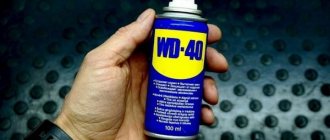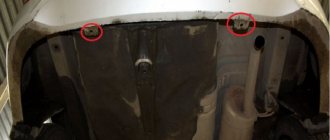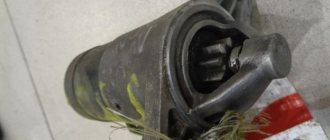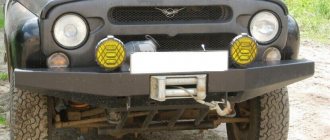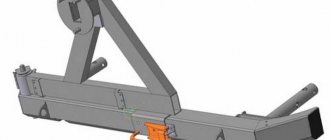1200 rub. for the photo report
We pay for photo reports on car repairs. Earnings from 10,000 rubles/month.
Write:
Painting a bumper yourself without good experience is quite problematic. It is important to have not only a suitable room, but also tools, as well as the ability to choose paint to match. To paint a plastic bumper, you will need to buy a primer (primer) specifically for plastic, and if it is an old bumper, then also putty for plastic. In addition, of course, a sanding machine, sanding wheels and a spray gun, although you can get by with spray cans if quality is not the main goal. When you have everything you need, and you are ready to try painting the bumper yourself, then knowing the sequence of actions and the nuances of the procedure will be very necessary. And it doesn’t matter whether it’s local painting or complete painting of a plastic bumper.
Necessary materials and tools for painting
- degreaser (after each stage of grinding), and it is best to purchase a special one for working with plastic surfaces, as well as several napkins.
- primer for plastic or, as they say, primer (200 grams).
- sandpaper to rub both immediately before priming and after priming the bumper, before painting (you will need P180, P220, P500, P800).
- a correctly configured spray gun, selected paint (300 grams) and varnish for the final touch. Without a spray gun, you can carry out all the necessary procedures with a spray can, but all bumper painting with a spray can is used only in local areas.
Preparing a car with significant damage
All of the above applied to the bumper, which had no physical damage. But often its surface has quite serious flaws, which must be removed before painting. Putty is used for this purpose. It is best to take one that is specifically designed for working on plastic. But you can also use ordinary car putty.
It is diluted at the rate of 1 part hardener to 50 parts putty. The time for complete hardening of the resulting mixture is short, and therefore it must be applied to damaged areas very quickly. For this putty to dry completely, 20 minutes is enough.
The surface of well-dried putty must be treated. For this purpose, sandpaper P 1000 or P 800 is stretched onto a small wooden block or secured in a special device. The grinding area itself is generously moistened with water.
You can, of course, use a sanding machine. But to do this you need to have at least some skills in working with it. Otherwise, you can create holes that will have to be puttied and sanded again.
The sanded bumper is washed with plenty of warm water and dried thoroughly. Then its surface is degreased using anti-silicone. Only after this can an acrylic primer be applied to it.
Step-by-step instructions on how to paint the bumper yourself
First of all, you need to decide on the type of work to be performed. That is, establish the scale of work based on the condition of the bumper. Is this a new bumper or an old one that needs to be restored to its original appearance? Do you need to repair the bumper or start painting right away? Indeed, depending on the condition and the task at hand, the procedure for painting the bumper will have its own adjustments and will differ slightly. But in any case, you need to thoroughly wash the bumper and treat it with a degreaser.
Painting a new bumper
- We rub it with P800 sandpaper to get rid of both the remaining transportation oil and minor flaws, after which we degrease the part.
- Priming with two-component acrylic primer. The bumper primer is made in two layers (the frequency of application of the next one depends on drying, it is necessary for the layer to become matte). If you are not a master in this matter, it is recommended to buy ready-made soil, rather than dilute it adhering to the required proportions.
- Rub or, as they say, wash the primer with sandpaper P500-P800 so that the base layer of paint sticks well to the plastic (quite often they don’t wash it, but simply lightly rub it dry with sandpaper, and then blow it off).
- Blow with compressed air and degrease the surface before applying the base coat of paint.
- Apply the buza and apply a couple more layers of paint at intervals of 15 minutes.
- After making sure that there are no defects or jambs, apply varnish to add gloss to the painted bumper.
Repairing and painting an old bumper
It is slightly different from the first case, since in addition one will need to treat individual places with putty for plastic; an additional step will be the elimination of defects, possibly soldering the plastic.
- You need to wash the part well, and then use P180 sandpaper to clean the surface, erasing the paint layer down to the ground.
- Blow with compressed air and treat with anti-silicone.
- The next step is to smooth out all the unevenness using putty (it is better to use a special one for working with plastic parts). After drying, first sand with P180 sandpaper, then inspect for minor defects and treat with finishing putty, sanding it with P220 sandpaper as well, in order to obtain a perfectly smooth surface.
We paint a new plastic bumper from a spray can
Previously, if it was necessary to replace a body part, the only option was to purchase a contract part at a car dismantling station or second-hand. This method has its disadvantages:
- it is very difficult to select a contract part that exactly matches the color of the car, and in addition to the cost of the part, you will have to pay for painting;
- a contract part may not be a contract part, but a used one; when repainting, a different color, putty, hidden damage may be discovered under the top layer of paint, and the cost of repainting will increase taking into account the repair.
A contract spare part is a part removed from a car that has no mileage in Russia. Let's say a Japanese car was used in Japan for several years, then the owner decided to exchange it for a new one, and the old one was sent to Russia to be sold for spare parts. Purchasing contract spare parts from a reliable company is a transparent transaction. You are provided with reliable information about the part; you can often see a photo of the car from which the part was removed, mileage, and an auction sheet with an estimate. The auction list always honestly states the condition of the car, and if any part has been repainted, the seller will know about it. But there are also cases when, intentionally, or simply without making a distinction, under the guise of a contract, the seller offers a used part - it has already been used in Russia, its history is unknown, and its condition can only be assessed visually. If it comes to auto body work, and you are not an expert in this field, there is a risk of buying just such a part, especially when it comes to a spare part, the reverse side of which cannot be seen without disassembling (for example, a door assembly with trim).
Today, the situation with the purchase of body parts has improved: companies have appeared that produce new body parts, and stores where these products are presented in an assortment. New parts, compared to contract ones, are inexpensive. Even if there is no such store in the city, you can order the product via the Internet, and be sure: you will receive a new part that has not been painted or repaired before.
Painting a new bumper is a real pleasure and doesn’t take much time or effort. The consumption of materials will be minimal, and difficulties in work can only arise due to your own mistakes.
What you will need:
- primer in a can (for plastic)
- spray paint
- varnish in a can
- degreaser
- antistatic
- clean cotton rag
- sandpaper P800
- bucket with water
- gloves
- sponge
- respirator (mask)
- protective glasses
- work clothes
The primer comes in different colors: white, different shades of gray, black. Despite the fact that the paint will completely cover the primer, choose the color of the primer based on the color of the paint: for light shades - light primer and vice versa. When selecting materials, carefully read what the manufacturer writes on the can about applicability, rules of use, and drying time. When selecting paint, be guided by the color code indicated on the plate under the hood; if the car was repainted in a different color, contact a colorist to mix the paint according to the sample. For a sample, the easiest way is to remove the gas tank flap.
Choose a suitable room. A suitable one is one in which there is no dust, ideally a paint booth. Many people do not attach any importance to this until they see that dust has settled on the product and all their work is in vain. When you work in a garage, at least try to cover the inside with film; if this is not possible, pour water on the floors. Place the bumper on a stand (for example, on a table) at a convenient height. Cover the stand with a soft cloth and film on top - this is necessary so as not to damage the fragile plastic with the corners. Choose a stand so that it rests against the middle part of the bumper at several points, but in no case rests against the edges: if during work you inaccurately press on the bumper, with such a support it may become deformed or crack.
The bumper is new, so it does not require special preparation for painting work. Rinse it with water, wipe it with a clean cloth, and cover it with an antistatic agent. Degrease, wait for the degreaser to dry completely, and begin priming. In order for the material (no matter whether primer, paint or varnish) to lay down evenly, always spray it at the same distance from the part. Start spraying outside the bumper, gradually moving onto it, and finish smoothly: do not make sharp boundaries in applying the material. Wait for the soil to dry completely. Degrease and add another layer of soil.
How to paint: step by step photos
This is what a non-original part looks like
Everything you need to paint a new bumper
First layer
Second layer
Two coats of paint
Two coats of varnish
Bumper on a car
As silly as it may sound, don't try to check with your fingers to see if the material is dry. Many beginners, wanting to finish the job quickly, try to check whether the next layer can already be applied. If a print on the ground is easy to remove, then getting rid of a mark on paint or varnish takes much longer than just waiting. Study the drying times indicated on the paint can, rely on these data, increased by 1.5–2 times, since your coating will probably turn out thicker than the manufacturer intended.
Take a bucket of water, cut a piece of sandpaper suitable for the job, dip it in water, place it on a sponge, and start washing the bumper. The primer coating turns out to be rough; if you leave everything as it is, after painting all the roughness will be visible. When the bumper becomes perfectly smooth, repeat the procedure: rinse with water, wipe, coat with antistatic agent, degrease, wait for it to dry. Now you can apply the paint in the same way as the primer was applied. After drying, apply a couple more layers of paint. After the last layer of paint has dried, we move on to the final stage - applying varnish. After applying the varnish, feel free to go home: there is nothing to do in the garage for the next 24 hours.
Video about carrying out work on cars
The next day you can return to the bumper and admire the result. But keep in mind that “admiring the result” is a figurative expression. Since the painting was not carried out under ideal conditions and without special equipment, despite your care and compliance with all precautions, you will probably see defects in the paintwork: adhered dust, bubbles, shagreen, dullness. Let this not be a reason for frustration: such defects can be removed by sanding and polishing, but it is better to do it not immediately, but 3-4 weeks after painting, since some defects appear only after the varnish has settled.
Painting nuances that should be taken into account
- Start work only on a well-washed and clean bumper.
- When degreasing the bumper, two types of wipes are used (wet and dry).
- If self-painting work is carried out with a bumper of Asian origin, it must be degreased more thoroughly and rubbed well.
- Do not use a hair dryer or other heating equipment to dry paint.
- When working with acrylic varnish, you need to follow the instructions that come with it, therefore, before you paint the bumper yourself, you need to carefully read all the instructions for the putty, primer, and paint as well.
- If smudges or shagreen marks form when painting, it is worth sanding with wet, waterproof sandpaper and treating the desired area with polish.
As you can see, painting a bumper yourself, adhering to the correct technology, is not so easy, since not everyone has a compressor, a spray gun and a good garage. But if this is for yourself, where the quality requirements can be even lower, then in an ordinary garage, having bought a can of paint and primer, it is quite possible for anyone to do a local bumper painting.
Partial painting: how to do it correctly
You will need:
- everything is the same as for completely painting an old bumper
- aerosol solvent
We proceed according to the same scheme as when completely painting, but we work only with the damaged part of the bumper. We remove the coating, sand the adjacent area, putty, level the surface, matte, prime, wash, paint, varnish.
Step by step pictures
Such a scratch can be removed locally
We use a grinding machine with a wheel of hardness P120
Cover the bumper under the ground
Apply primer and wait for it to dry
The primer has dried
Sand after complete drying
We increase the repair area for paint
First layer of enamel
Second layer of enamel
Wait for it to dry completely and see the result
Bumper after painting
Please note: the scratch may be small, but the area of each subsequent step should increase. Let's say you removed the coating from a circle with a diameter of 5 cm; putty overlapping the part that was not removed - it turned out to be a circle with a diameter of 9 cm; rubbed the putty over the paint - 15 cm; prepared the surface for priming and again increased the area of repair - the diameter of the circle is already 19 cm. The numbers are indicated only to clarify the recommendations, you do not need to rely on them: just expand the area of work with each step, then you can achieve uniform painting.
Example of aerosol painting on video
The only new action that appears when partially painting the bumper: after varnishing, coat the part of the paintwork adjacent to the area to be repaired with an aerosol solvent. This will make the transition from the repaired area to the non-repaired part of the bumper smoother.
Preparing tools and materials
Their number and volume directly depend on the scale of the work performed. How many cans of paint do you need to paint a bumper? If partial repairs are being carried out, one volume of 500 milliliters is sufficient.
- Primer.
- Putty (for deep damage or dents that could not be restored by heating).
- Degreaser (white spirit or “anti-silicone”).
- Sandpaper of varying degrees of grit.
- Polishing machine with felt attachment.
If a partial repair is being carried out, it is important to ensure that the product is as shiny as possible. How many cans are needed to paint a bumper with varnish? One or two is enough. The varnish should be colorless. Also, do not forget about protective measures - prepare goggles, gloves and a respirator.
What's next?
At the next stage we need to correct the previous defects. These may include scratches and light dents. If the bumper has a crack, it is repaired with epoxy glue from the back side. In order to level the surface from the outside, use automotive putty.
It is mixed with a hardener and applied with a spatula. Please note that the paste dries quickly (less than 10 minutes). You need to mix the putty in small volumes. After drying, take a block of sandpaper and smooth out all the edges. It is important to ensure maximum smoothness and uniformity.
Remember that the final result of the repair depends 90% on quality preparation.
Preparation
First you need to decide how to paint it. If this is painting a new bumper with a spray can, it is better to carry out the work with removal. For partial restoration, you can leave the bumper on the car and apply the compound locally. But remember that due to the complex geometric shape, it is very difficult to achieve a uniform layer. Drips may form if the bumper is painted on site.
Primer
The sanded putty will definitely leave pollen behind. Its presence on the surface is not at all desirable.
Note! The bumper has its own primer. When purchasing, check with the seller that you need the material specifically for plastic surfaces.
Then we apply the composition in several layers. Usually the bumper is processed in two passes. Between the first and second layers you need to take a 15-minute break. Give the composition a chance to dry. After the second layer, the bumper is sent to dry. It lasts 24 hours at a temperature of 20 degrees. The process can be accelerated by using an infrared heater.
Technology for painting the entire bumper with a spray can
So, our bumper is completely prepared for final painting. But its technology will differ depending on whether it is a complete repair or a local one. Let's consider the first case.
In this situation, the entire area of the element is treated with paint. First you need to make a developing layer. It will be the thinnest. In order not to form drips, we spray the composition at a distance of no closer than forty centimeters at a speed of 0.5-1 meter per second. Then we wait until this layer dries on the primer. It is enough to wait 15-20 minutes. Then you can apply a second, thicker layer. But make sure there are no drips. Do not bring the spray tip too close to the element. Keep it strictly perpendicular to the surface. Pay attention to hidden cavities. After 20 minutes, apply another finishing layer. If the shade turns out to be pale and unsaturated (and the paint was registered), we cover the bumper again. It is necessary to achieve the same shade as the factory surface.
If all that remains of the bumper is the name: damage repair
If your plastic bumper is full of cracks and holes, then do not rush to throw it away and buy a new one. Even if the bumper falls to pieces, it can be fixed if desired.
- everything that is required to paint an old bumper
- industrial hair dryer with narrow nozzle
- soldering iron with a wide tip (1 cm or more)
- flat electrodes (take several types in stock)
- putty for repairing plastic
- heat-resistant tape
- drill
A flat electrode is a strip of polypropylene suitable for repairing cracks in plastic bumpers. Electrodes are divided into several types depending on the thickness and type of plastic. Find the material markings on the inside of the bumper, and in the store select the types of electrodes suitable for this plastic.
Just like when painting an old bumper, we remove the coating with a grinding machine with a P120 wheel. In places where there are cracks, remove the coating completely, down to the plastic. We remove dust and degrease the area of the crack, connect both parts and glue them to the outside of the bumper with heat-resistant tape. We turn the bumper over and work on the inside. At the crack site, we use a soldering iron to make a groove into which we will place the electrode. Do not press the soldering iron too hard, do not hold it in one place for a long time, so as not to tear the bumper. Make the groove 2–3 centimeters longer than the length of the crack. When the groove is ready, select an electrode of suitable thickness, apply it to the beginning of the groove and start heating it with an industrial hair dryer. When the electrode “floats”, pressing it, place its beginning in the groove, and thus, heating it at the base and pressing it, place the entire electrode. Wait until the plastic hardens and cut off the excess.
Features of local painting
The main task is to make the transition to the factory paint layer as smooth and imperceptible as possible. The problem is further complicated by the fact that the shade of the factory paint may fade (paint slowly but surely fades in the sun).
- We increase the spray distance as the torch approaches the layer of factory paintwork.
- With each new layer we move the imaginary border further and further from the repair site.
- We do not use masking tape under any circumstances. It leaves a strong and noticeable transition. You can use tape and film only to protect adjacent body elements if the bumper is painted without removal.
- Varnish, unlike paint, is applied to the entire surface area. This way we will hide the difference in shades if the bumper is old and a little faded. We will also get rid of the dullness in the transition line.
Next, similar to the previous case, we wait for the paint to dry completely and after a couple of days we polish the surface.
Premises requirements
Do not under any circumstances perform this operation outdoors - only indoors.
- Carry out a complete wet cleaning. The slightest pollen falling on the surface will be clearly visible on a bright day, even from a great distance.
- Distribute work areas in advance. If you are painting the VAZ-2114 bumper with a spray can and removing it, prepare hooks to engage the element in a horizontal position. You should not place the part vertically - drips will form.
- Ensure ventilation, as painting work must be carried out with the gate closed.
- Provide quality lighting. The more light, the easier it is for us to notice and eliminate any defect.
Reasons for painting
The bumper must be painted in the following cases:
- The car is many years old, although the plastic bumpers do not bloom and do not rust like the metal of the body, but over time the paint begins to fall off from them piece by piece.
- The bumper suffers the most in collisions. In such cases, either buy a new one and paint it, or restore the old ones, if possible.
- Even after purchasing a new car, some drivers have noticed that the paint on the bumpers begins to peel off. This is most likely due to non-compliance with the technology when carrying out paint and varnish work or the quality of the paint itself.
How to paint bumpers: methods
You can paint bumpers yourself, in makeshift conditions, in several ways:
- brushes (can be used for invisible areas, because stains are visible);
- with a spray can (one of the popular and easy ways to apply paint);
- spray gun (a compressor, a hose and a gun for spraying paint are required).
Some large auto manufacturing plants have a method where parts are dipped into a paint bath. This method is used by manufacturers of expensive cars (Ferrari, Lamborghini, etc.). And even AvtoVAZ, they say, those cars that were exported to India were painted in this way (dipped in a bath). For the domestic market, VAZ cars are painted using the application method.
Paint selection
The choice of paint is very important. The correct selection of materials of this type gives positive results on different surfaces. Higher quality and more expensive paint is much better than cheap paint, however, the quality of its application also depends on the surface being treated.
The right choice of spray paint depends on its color and shade. The best way to make a selection is to study the catalog, and the seller can give advice on a particular type of paint. In addition to paint, you may also need a primer and varnish for the job, and they should also be selected in accordance with the coating being treated. Both of these products are also best taken in aerosol form in a can. The primer should be colorless or match the color of the paint that will cover the entire part. Choosing a paint tone can be very difficult. Having a catalog of aerosols and being near the car, it will be easiest to choose a color.
DIY painting materials and tools
Work such as painting or tinting the rear window with your own hands does not in any way affect the operation of the engine and other parts, so a completely inexperienced beginner can do it. It is clear that a beginner should not attempt to repair engines and other complex technical products alone. In order for the result to be of high quality, you must follow the technology and use the following materials and tools:
- Personal protective equipment (PPE). These are gloves, a respirator or gas mask, overalls (robe).
- Degreasing liquids.
- Primer.
- Putty. It is desirable that the putty contains fiberglass.
- Sandpaper. It is necessary to sand with sandpaper before and after priming work. Sandpaper markings: P120, P180, P220, P500 and P800.
- Electric grinding machine.
- Depending on how you paint, you will need a spray can or a spray gun.
Advantages and disadvantages of the method
If the paintwork is only slightly damaged, many people try to avoid an expensive painting procedure.
In addition, this procedure can be carried out on your own by purchasing the appropriate cans of paint. It is important to carry out the procedure in the appropriate room and in compliance with all technologies.
Before that, you can evaluate all the advantages of this method:
- To carry out such painting, no special skills or preparation are required;
- using a spray can you can carry out high-quality repairs;
- any surfaces are covered, hard-to-reach places and bends are much easier to paint; no additional components in the form of a roller, spray gun, etc. are required during the work;
- if you have no experience in painting, you will be able to apply an even layer of paint;
- to apply an even layer you do not need to work with a roller or brushes;
- Spray painting will cost less than other means; this service is available to many motorists.
However, it is necessary to realize that all painting methods have their own nuances and disadvantages.
Spray painting is no exception to this issue, so be prepared for the following disadvantages:
- there are no detailed instructions on the rams for painting;
- Sometimes you come across cylinders of poor quality, so before applying to a car, test on another surface;
- Sometimes the declared shade and the real one may differ, so you should immediately purchase the required amount.
Select the color scheme in accordance with the labeling, but if you are still not sure of your choice, then you should consult with the experts in their field.
He will be able to carry out tinting using special equipment.
If the depth of the chip or scratch is insignificant, then it is not necessary to resort to painting; you can polish it.
If primer or metal is visible in the damaged area, then the work will be more serious and eliminating the defect will take longer, as will painting the damaged part of the body.
Spray painting a car is a step-by-step procedure that is ideal for doing it yourself, which allows you to save money at the same time.
This method is suitable for working with a small area of damage, but if the problems are serious, then contacting a service station cannot be avoided. All work will be carried out there in a special box.
Sequence of work when painting a bumper yourself
Painting is not a job that can be done haphazardly, although many people think so. In order to prevent the paint from flying off later, you will need to follow a certain sequence:
- Preparatory work.
- Grinding work.
- Puttying (puttying).
- Applying primer.
- Sanding after priming.
- And finally, applying the paint.
Step No. 1 Preparatory work
- After dismantling, if we paint the old bumper, we proceed to a thorough wash with the addition of a cleaning agent (Fairy, Drop, etc.). If there is tar on the surface of the old bumper that cannot be washed off, it must be carefully removed with either a knife or a chisel.
- After washing and mechanical cleaning of dirt, we use a solvent, preferably WHITE SPIRIT or 646 solvent. Old paint must be removed with a spatula. If it doesn’t come off well, then by purchasing a special remover, for example, VIKA 0.5 l, the process of stripping off old paint, even with an anti-gravel coating, will easily come off. You need to apply this solution with a brush several times, then wait about 10 minutes and it will also come off easily with a spatula.
- Such special substances for removing old paint, for example, VIKA or BODI, require careful handling. Namely, work with rubber gloves, because it burns the skin and smells terrible.
- After all the old paint has been removed, you need to remove the remover with dry rags and, only then, wash everything with solvent.
Grinding work
- Some people simply use a mechanical method to remove old paint and old primer. But using a drill or screwdriver with an emery attachment spoils the plastic itself. Therefore, it is better to use chemicals to remove old paint.
- Those who still want to use the mechanical method will need a grinder. First of all, we sand with coarse sandpaper 120. If there are scratches, we smooth them out with a block and remove all burrs.
- If medium and microcracks are detected, you can weld them with a regular soldering iron. And large cracks are welded on both sides with oblong electrodes.
Painting a new bumper
A new bumper also needs to be prepared for painting, especially since new products are coated with various protective oils that need to be removed. They may also be partially damaged during delivery of the goods.
- Step #1. We take sandpaper number P800 and start sanding. New products have burrs that need to be cleaned out.
- Step #2. We degrease the new polished bumper from the factory shipping oil.
- Step #3. We begin priming with a 2-component acrylic primer. After applying the first layer, wait until it dries. We begin applying the second layer after the first layer becomes matte. Beginners are advised to purchase ready-made diluted soil, since dilution requires strict proportions.
- Step #4. We take sandpaper (sandpaper) from P500 to P800 and rub the primed layer. Thanks to this grouting, the primer is permanently glued to the plastic.
- Step #5. Blow off crumbs with a compressor.
- Step #6. Degrease with solvent.
- Step #7. Apply buza and apply paint in layers. Wait 15 minutes between coats.
- Step #8. Glossy coating.
Useful tips
In order to be satisfied with the work done by yourself, here are some tips:
- It is necessary to paint in a moderately warm room, where there are no drafts. If there is a draft, there will undoubtedly be sand and dust on the parts to be painted, which will significantly complicate the work.
- Regardless of whether the new bumper needs to be painted or the old one, it must be washed and degreased. If you do not degrease, the grease film will not allow it to stick firmly to the plastic and very quickly the new paint will crack and burst.
- For degreasing you need wet and dry wipes.
- Do not use a hair dryer to speed up the drying of applied layers of primer, paint and varnish. Drying naturally is better.
- Read the instructions and recommendations for working with varnish and paint. So, as a rule, it contains useful information, especially for beginners.
- If a leak suddenly appears, it must be removed. Clean the area with moisture-resistant sandpaper and polish.
Bumper preparation
The bumper is rightfully considered the most vulnerable part of a car. Its direct purpose is to absorb the force of impact in a collision. In addition to taking the impact, it can be damaged if parked incorrectly. Repairing a bumper after deformation can be very expensive. Therefore, many car enthusiasts refuse such painting at a service station. Doing the painting yourself may be cheaper, and the procedure itself is not very complicated or difficult.
Repairing a plastic bumper may require certain materials and tools. Among them are a grinding and polishing machine, an electric drill with attachments - it is used for the same purposes. A powerful soldering iron that will be able to connect broken parts, sandpaper of varying hardness, solvent, primer, putty, varnish and paint. The dyeing technology is simple, but requires knowledge and a certain sequence. If you want to see for yourself exactly how the preparation and painting process goes, you can watch a video that describes in detail all stages of the work.
Without dismantling it is impossible to paint a car bumper really well. The stages of preparation for painting include removing the bumper, washing in warm water, and treating the damaged areas with sandpaper after drying. After this, washing and drying are repeated, and the surface cleaned with sandpaper is treated with anti-silicone. Surface degreasing can be done with a special compound for plastic. The best in this case is still anti-silicone. After treatment, you can know for sure that the paint will behave normally, covering the part and the treated areas, since different paints may react inadequately to different types of solvents.
The complexity of the damage may vary. Depending on how heavy it is, the method of repair and painting also varies. However, the technology for painting the front and rear bumpers is almost the same and differs little. What reasons could there be for you to resort to spray painting your bumper yourself?
- Cosmetic damage and defects. Small scratches and damage can significantly affect the effectiveness and appearance of the bumper. In such cases, they resort to minor cosmetic repairs. The procedure is simple and does not require significant financial costs or complex instruments. Careful sanding and applying paint can completely solve the problem.
- Chips, cracks and dents can be a more serious problem. Such damage requires preparation before removal and a more complex work process. Before painting, the bumper must be leveled. For this, hard plastic or putty is used.
- If the bumper is cracked, it will need major repairs. Such repairs can be difficult, but in most cases it is quite possible to restore the bumper to an acceptable condition.
